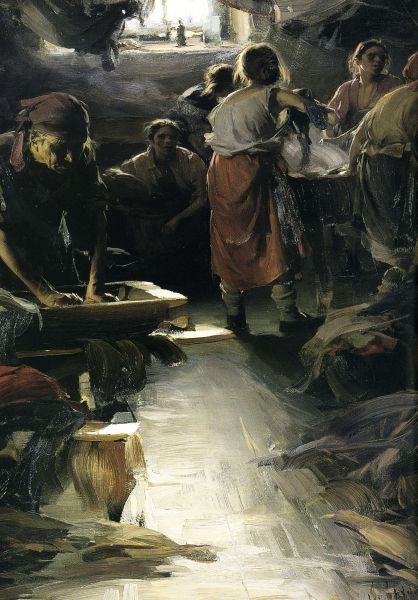|
|
Laundresses. Circa 1898

Arkhipov Abram,
Oil on canvas
97 x 65,5
State Russian Museum
Annotation
This is one of the most important works in Abram Arkhipov’s oeuvre. Painted in a refined silver-grey colour scheme, it was created following the artist’s visit to the laundries at the Smolensk Market in Moscow.
His wide plastic strokes freely mould form, subordinating the uncoordinated movements of the women to the single encompassing rhythm of their labour. The figures are immersed in a dense and poisonous light-aerial environment saturated in moisture and toxic fumes. While reflecting the inhuman work conditions of the laundresses, the work also presents Arkhipov with an interesting and complex painterly task, one that he resolves masterly.
Author's Biography
Arkhipov Abram
Arkhipov, Abram Yefimovich
1862, Yegorovo (Ryazan Province) - 1930, Moscow
Painter, teacher. Studied under Vasily Perov, Alexei Savrasov and Vasily Polenov at the Moscow School of Painting, Sculpture and Architecture (1877-83, 1886-88) and at the Imperial Academy of Arts (1884-86). Academician of painting (1898). Full member of the Imperial Academy of Arts (1916). Member of the Society of Travelling Art Exhibitions (from 1891), founding member of the Union of Russian Artists (1903) and member of the Association of Artists of Revolutionary Russia (1924). Contributed to exhibitions (from 1880). Contributed to the periodical exhibitions of the Moscow Society of Lovers of the Arts (1889-93), Society of Travelling An Exhibitions (1889- 1901), 36 Artists (1901, 1902), World of Art (1903), Union of Russian Artists (1903-22), Association of Artists of Revolutionary Russia (1923-28), World Exhibition in Paris (1900) and the International Exhibitions in Dusseldorf (1904), Munich (1909, golden medal) and Rome (1911). Taught at the Moscow School of Painting, Sculpture and Architecture (1894- 1918), State Free Art Studios (1918-20) and Higher Art and Technical Studiosin Moscow (1924-24). People''s Artist of the Republic (1927

